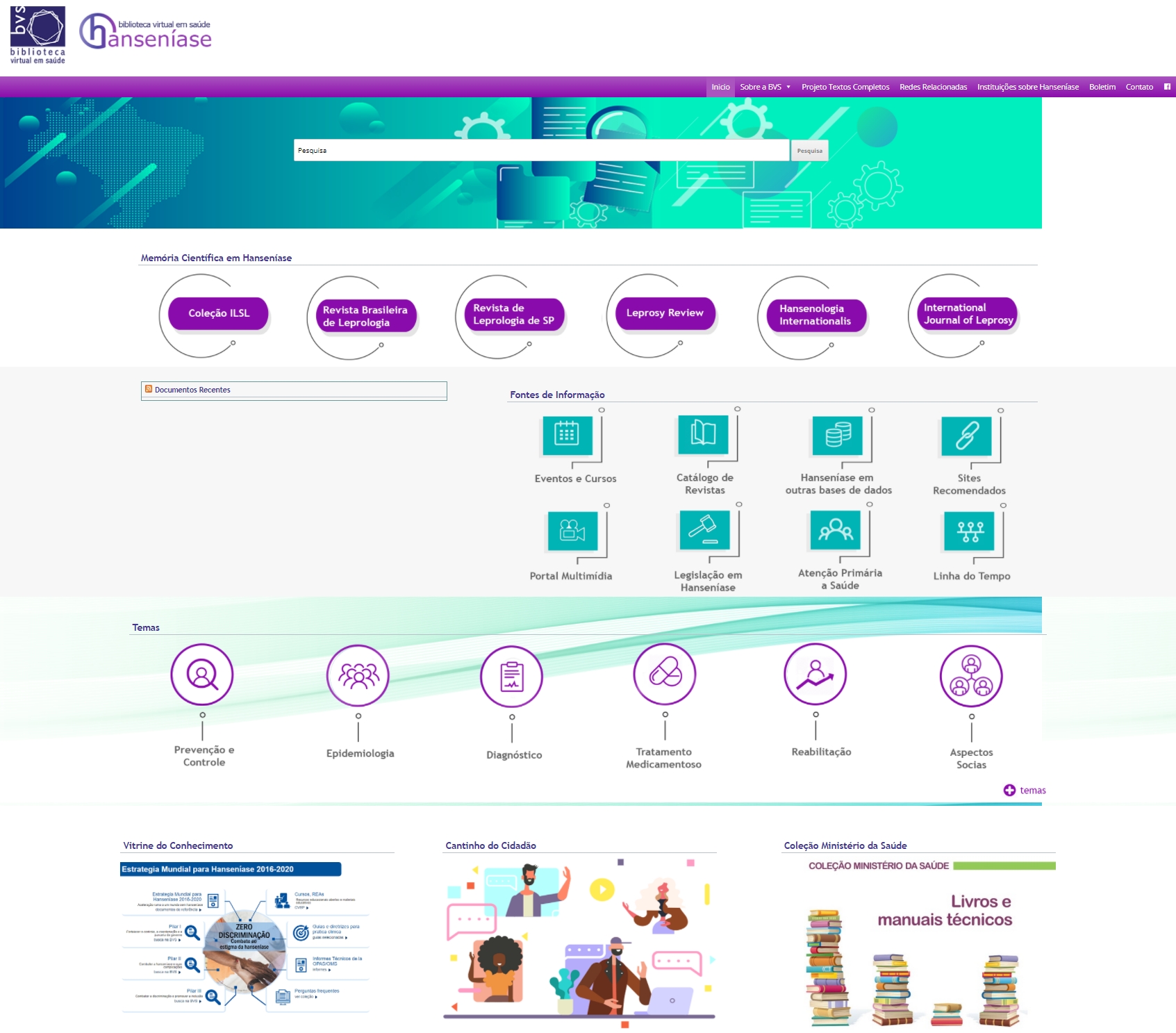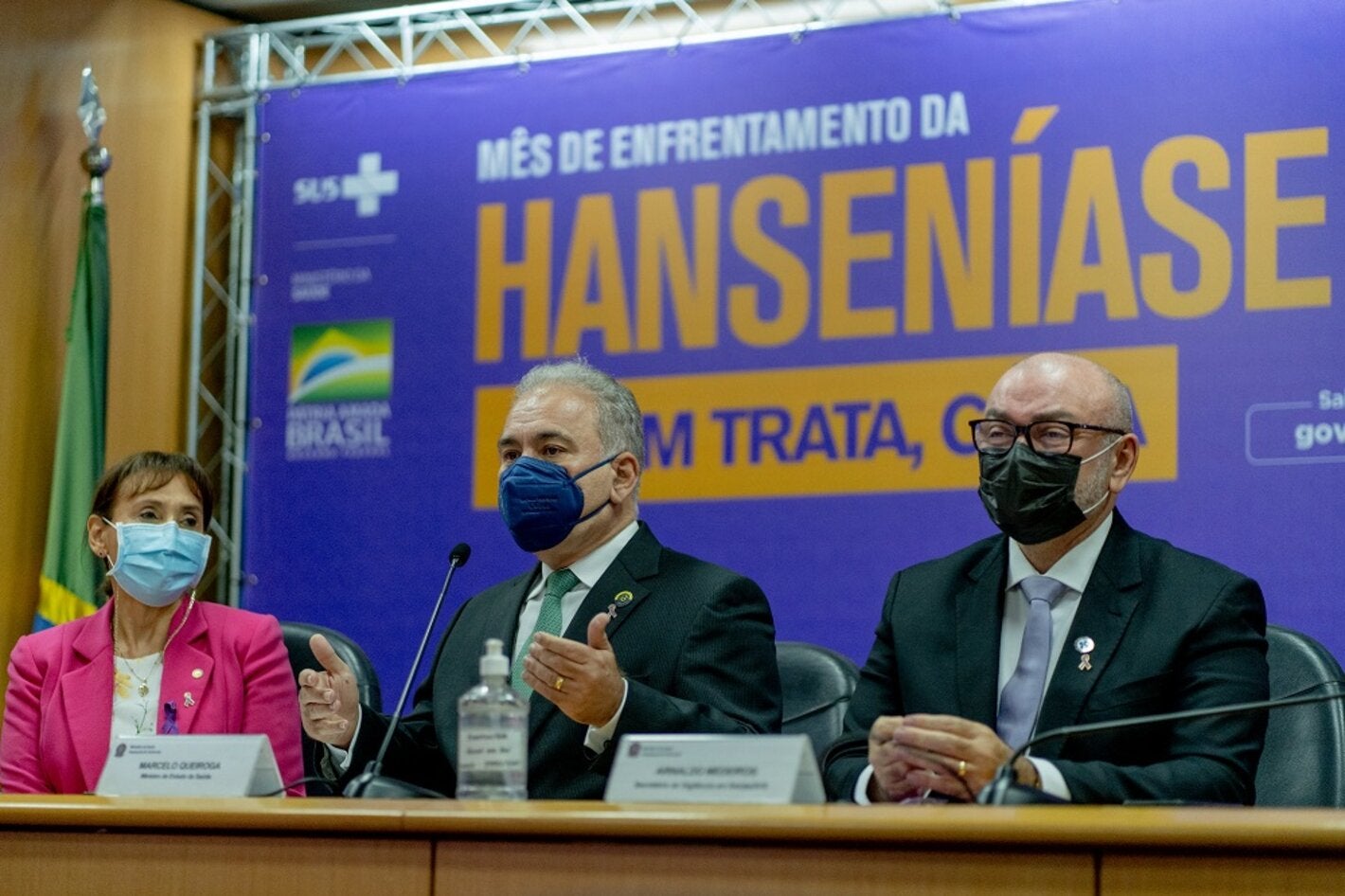The Cooperation Term 71 (TC71), established between the General Coordination for the Surveillance of Diseases in Elimination of the Department of Diseases in Chronic Conditions and Sexually Transmitted Infections of the Health Surveillance Secretariat of the Ministry of Health of Brazil (CGDE/DCCI/SVS/MS) and PAHO/WHO Brazil, through BIREME, aims to develop activities for the improvement and strengthening of public policies for surveillance and prevention of leprosy and other diseases in elimination recommended by the Unified Health System (SUS).
The Virtual Health Library on Hansen’s Disease (Hansen’s Disease VHL) was created in 2007, being coordinated by the Instituto Lauro de Souza Lima in cooperation with BIREME/PAHO/WHO and with the support of national and international institutions with recognized experience in the area. It is a thematic VHL, whose objective is to gather, organize, and disseminate national and international scientific and technical production, contributing to the development of studies and research that facilitates the preservation of history, and to the prevention and treatment of leprosy.
 Within the scope of TC71, VHL Hansen’s Disease was restructured with new information architecture and had its technological platform updated, in addition to expanding its collaboration network with the inclusion of new institutions in its governance bodies and promoting the use of the best evidence to support decision making in health.
Within the scope of TC71, VHL Hansen’s Disease was restructured with new information architecture and had its technological platform updated, in addition to expanding its collaboration network with the inclusion of new institutions in its governance bodies and promoting the use of the best evidence to support decision making in health.
As the VHL is an important information source and reference on Leprosy, as a result of this partnership it was possible to promote the regular operation of the VHL and its information sources, such as the main database of the VHL, Hansen Database, currently updated with almost 20,000 records and the review of thematic areas with the inclusion of a new topic on the Social Aspects of the disease, which makes about 1,800 documents available.
The Ministry of Health Collection was also developed, which aims to bring together all the technical publications on leprosy from the Ministry of Health in a single place in order to facilitate access and dissemination of validated and qualified information about the disease to health professionals. The Collection is available through the VHL search interface, the filter for retrieving information from the Second Formative Opinion (SOF) on leprosy and the update of the historical timeline of leprosy was created, which aims to record and document the main facts and remarkable events in the history of leprosy in Brazil , covering the period between 1741 and 2010, in addition to the development and elaboration of publicity materials such as banners, folders, badge cords, pencils, notepads, and ecobags.
For 2022, the collection of Rare Works on Leprosy is planned to be made available, a collection of books dating from the 17th to the 20th centuries and documents that portray the history of leprosy and the ILSL, the completion of animated/interactive videos on the main VHL information sources and the translation of the VHL portal into English and Spanish, thus aiming at a greater reach of VHL users.
In celebration of World Leprosy Day, which took place on January 30, BIREME/PAHO/WHO developed and launched the Leprosy (Hansen’s Disease) Window of Knowledge, which contains information for health professionals, researchers, and the general public and is available in Portuguese, English, and Spanish. The window of knowledge provides current documents on the topic, highlighting the World Day, search strategies on the “End of stigma and discrimination” and “Leprosy and COVID-19”, videos, websites of interest, among others.
World Leprosy Day
World Leprosy Day is celebrated on the last Sunday in January. In 2022, it will be on January 30th, and the campaign is called United for Dignity – #United4Dignity. This international day is an opportunity to honor people who have been affected by leprosy, raise public awareness of the disease, and work to end the stigma and discrimination associated with it.
Leprosy is an infectious disease caused by the bacterium Mycobacterium leprae or Hansen’s bacillus. The bacillus reproduces very slowly and the average period of incubation and appearance of signs and symptoms is approximately five years. Initial symptoms are light or dark patches or nodules on the skin, resulting in skin lesions and loss of sensation in the affected area. Other symptoms include muscle weakness and a tingling sensation in the hands and feet. When cases are not treated at the onset of signs and symptoms, the disease can cause progressive and permanent sequelae, including deformities and mutilations, reduced limb mobility and even blindness.
People affected by leprosy are often discriminated against and stigmatized. This situation has a negative impact on access to diagnosis, treatment, and care outcomes, in addition to violating civil, political, and social rights. Ending discrimination, stigma, and prejudice is essential to ending leprosy.
Leprosy is not highly infectious and is spread through close and frequent contact with untreated infected people. Leprosy is curable and the treatment offered considerably reduces the chances of disability. Today, leprosy treatment is free (through the WHO, thanks to a donation from a pharmaceutical laboratory) and simple. Most endemic countries have made efforts to integrate leprosy care services into their national health services.
 On World Leprosy Day 2022, Brazil announced the inclusion of new laboratory tests complementary to the diagnosis of leprosy, including a rapid test, in the public health system. The launch took place at an event at the country’s Ministry of Health, with the participation of PAHO. The PAHO/WHO representative in Brazil, Socorro Gross, said that Brazil is a reference in the area for the Region of the Americas and the world, not only because of the disease burden, but also because of its technical capabilities, human resources, strategy, political positioning, and solidarity in sharing knowledge. “Brazil’s advancement today is an advancement for the whole world. Introducing a rapid test means having an early diagnosis, which, for a disease that has a cure, will give us the opportunity to talk about the eradication (of leprosy)”, she highlighted. Helping people who have this disease is an issue for all of us and more than a commitment, it is a duty, and we are doing our part, as universal public health”, highlighted the Minister of Health of Brazil, Marcelo Queiroga.[1]
On World Leprosy Day 2022, Brazil announced the inclusion of new laboratory tests complementary to the diagnosis of leprosy, including a rapid test, in the public health system. The launch took place at an event at the country’s Ministry of Health, with the participation of PAHO. The PAHO/WHO representative in Brazil, Socorro Gross, said that Brazil is a reference in the area for the Region of the Americas and the world, not only because of the disease burden, but also because of its technical capabilities, human resources, strategy, political positioning, and solidarity in sharing knowledge. “Brazil’s advancement today is an advancement for the whole world. Introducing a rapid test means having an early diagnosis, which, for a disease that has a cure, will give us the opportunity to talk about the eradication (of leprosy)”, she highlighted. Helping people who have this disease is an issue for all of us and more than a commitment, it is a duty, and we are doing our part, as universal public health”, highlighted the Minister of Health of Brazil, Marcelo Queiroga.[1]
January 30th also marks a global movement in favor of Neglected Tropical Diseases (NTDs). World NTD Day serves as a catalyst to translate awareness into action, secure more resources for NTDs, and facilitate political leadership and ownership of NTD programs in affected countries. On January 30th, 65 monuments from 26 countries in 43 cities on five continents will be illuminated (Brazil will participate with the statue of Christ the Redeemer, in Rio de Janeiro) in a collective action to eradicate NTDs together. This goal is in line with the WHO resolution to eliminate at least one NTD from 100 countries by 2030.
Links of interest
Virtual Health Library Hansen’s Disease – https://hansen.bvs.br/
Window of Knowledge Leprosy (Hansen’s Disease) – https://bvsalud.org/vitrinas/en/post_vitrines/leprosy-hansens-disease/
PAHO – Leprosy – https://www.paho.org/en/topics/leprosy
PAHO – World Neglected Tropic Diseases Day 2022 – https://www.paho.org/en/campaigns/world-neglected-tropical-diseases-day-2022
International Federation of Anti-Leprosy Associations – https://ilepfederation.org/
World DNT Day – https://worldntdday.org/
WHO World Leprosy Day 2022 – https://bit.ly/3ubjEPi
[1] Source: PAHO Brazil. Brazil strengthens leprosy diagnostic capacity. 01.25.2022. Available at: https://www.paho.org/pt/noticias/25-1-2022-brasil-fortalece-capacidade-diagnostico-da-hanseniase